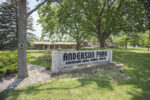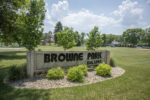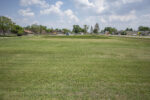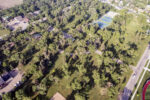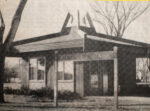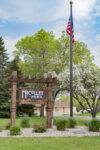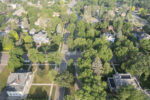

It’s hard to imagine that Aberdeen was a baren grassland when the railroads first took interest in the location that would evolve into our town. It is said, in many historical accounts, that all the trees that have graced our landscape over the years were planted by hand. In fact, tree planting was encouraged when applying for land when the area opened up for claims. We see remnants of these tree claims around the edges of town, namely Melgaard and Wylie parks. Both were originally tree claims, planted with hundreds of trees by homesteaders looking to obtain government land. But they weren’t “parks” back then as we know them today. In reading the Brown County History book (“BCHB,” the great book published prior to Aberdeen’s centennial), has great stories of many of our parks and how they came to be.
There were attempts to plant trees as early as the community got going in 1880 on these tree claims. The claimant had to plant and maintain 10 acres of trees. But there were no official “parks” planned. The town did have multiple artesian wells strategically placed around town. Trees were planted near each of these wells, and they became known as “beauty spots,” according to the BCHB.
The state of South Dakota passed a bill that went into effect July 1, 1909, that would allow for municipalities to establish park boards. Aberdeen Mayor Alva N. Aldrich jumped on the opportunity and appointed four men in March to serve on an inaugural board of directors in anticipation of the bill. He made C.N. Harris the Chair and appointed A.E. Boyd, C.F. Easton, Dr. Carl Fossum, and S.C. Hedger. They immediately designated all 14 artesian beauty spots as parks and added Riverside Cemetery to their oversight. Eventually parks would bear the names of Aberdeen citizens for a variety of reasons. We all know the names, but do we really know the persons?
In a 1906 article in the Aberdeen American, the “north side” featured the only park in town at the time located on the former site of the first Brown County Courthouse, or city hall. It talks about the plan and efforts already underway to plant trees and flowers. The park would be named Aldrich Park after Mayor Aldrich, who was mayor at the time. We all know this park today as the one with the bandshell/gazebo located on north Main Street beside Dakota Outdoors bicycle shop. The park was designed to have sidewalks running diagonally from corner to corner with a fountain in the middle filled by, you guessed it, an artesian well.
Alva N. Aldrich came from Michigan in 1889 to homestead in Frederick. His farming venture did not succeed, he sold his land at a loss and came to Aberdeen two years later and became a clerk at a clothing store. He changed jobs and went work at the Wisconsin Hotel downtown Aberdeen owned by James Wylie. In 1895 he married Wylie’s daughter Louisa, then the following year acquired the hotel from Wylie. He matured with the growing town and eventually was elected mayor in 1904 after serving a couple years as an alderman. In the aldermanic form of government, he served as mayor for three two-year terms. When the city changed to the commission form of government in 1911, he served additional terms, starting in 1916 through 1921, then retiring from politics. He passed away in 1945 leaving his wife, and three children, Louis, Edith (Meyer) and Lorraine (Roesch) and several grandchildren.
James Wiley was an Aberdeen pioneer and opened a hotel called the Wisconsin House on the corner of Main Street and 1st Avenue in 1882. He had claimed land northeast of Aberdeen and planted a tree grove. He and his wife had four children, Mrs. P.T. Burns, Mrs. J.C. Kuney, Louisa, and Bessie. Louisa married Alva Aldrich After Wylie’s passing and the couple lived in the Wisconsin Hotel. The tree claim became known as Aldrich Grove. Aldrich offered to sell the 160-acre plot of land to the city for a park. The Aberdeen Railroad Company (streetcar/trolly) company offered to donate an additional 30 acres adjacent to Aldrich’s land for the purposes of building a lake to complement the park if the city would purchase the land from Aldrich. The deals were made in 1910, and the rest is Wylie Park history.
On May 5, 1909, Andrew Melgaard, an Aberdeen pioneer like Wiley, announced he would donate 11 acres of his tree claim on the south side of the town and that it should be called Melgaard Park. He also offered to sell an additional 14 acres to the city for $250 per acre, about a quarter of the going rate. He also included a circular driveway or boulevard that would allow for traffic in the 25-acre park. The city council and the newly created park board were very excited to have a park with a fine collection of established trees. Something they recognized would take over 20 years if they were starting from scratch. This was such big news to the city they began planning to open State Street to the south so that it would connect with the driveway in the proposed new park (it never really connected, but it’s close). Melgaard homesteaded on this site in 1880 and planted the trees at that time. He filed on land just south of what is now the park on June 4, 1880, and 5 hours later, the townsite of Aberdeen was claimed by the Milwaukee Road’s Charles Prior. Melgaard’s family came to Aberdeen in spring of 1881 from Minneapolis to farm. The Melgaards had a total six children in Aberdeen. Melgaard Park would be in constant development with the addition of screened picnic shelters, a wading pool, changing compartments, a touring camp area that could park 50-60 cars in the 1920s.
In 1931 the city honored Andrew Melgaard by erecting a bronze statue of him in the park he gave to the city. Andrew had died in 1911, shortly after retiring. Three of his children (Herrett, Oscar, Harold) and his wife, Ida, unveiled the statue in a ceremony at the park that included two former mayors and the current mayor, I. N. Douglas. In his address, Douglass noted that Andrew was not a public figure but was always interested in public improvements. His obituary states he was a progressive farmer and endured the harsh South Dakota weather for over 30 years.
Many don’t realize that 6th Avenue was originally called Nicollet Avenue. The land that became the Nicollet Park was given to the city by Arthur and Dela Boyd in 1908. As we all know, it’s a small piece of land adjacent to the road north of Burger King. It was popular for touring motorists when the Yellowstone Trail went past it. Many remember an octagon shaped building that sat in the park. This was used as the city’s visitor center for years. A chainsaw sculpture of a Native American was carved on site and installed in the park in the 1980s.
Because she thought the kids of the northeast section of Aberdeen needed a park and playground, Mrs. J.L. Browne donated land for a park in 1928, then another portion in 1943. James Browne was a banker involved in Isaac Lincolns Bank. Today, this park on northeast Third Avenue and North Jackson still exists and features a ball diamond and playground. It used to feature a skating rink, and in the 1930s was a prime location for many of the city’s summer park programs.
Soph Anderson was the superintendent of the parks from 1915 – 1931 and was involved until his death in 1945. Subsequently Anderson Park was named after him on east Sixth Avenue along the Moccasin Creek. The Aberdeen Senior Center building was built in this 25-acre park as a W.P.A. project in 1946 with rocks and stone from the Webster and Waubay areas. This park and center were originally called the Anderson Recreation Center.
There was a park north of Lincoln Elementary school. It was known as Westside Park (as well as West Hill Park). The artesian well there provided for a wading pool. Later the park was renamed Frontier Park and various themed playground equipment, including tipi shaped monkey bars, were installed (and replaced in later years).
A four-acre piece of land west of Lincoln School became known as Lincoln Park when Mayor Aldrich donated the land. Many kids in West Hill (including me) practiced baseball in this area for years. It used to be entirely flooded in the winter for ice skating, but now only half of it is used as a rink.
Garfield Park just west of State Street on 8th Avenue SE was named for the elementary school that used to sit on that block. Before World War I, kids from Garfield school would walk to Nicollet Park each year to plant a tree.
One of the most surprising parks, that sort of inspired this story, is one called Waldron Park. It is practically unknown by name, but recognizable by many. It is actually the median between First and Lincoln Streets on 12 Ave NE. Over 100 trees were planted there in 1912 by the city. David A. Waldron purchased 120 acres of land north of Aberdeen in 1887. The area was known that far back as the Highlands. We know this area today as the name given to Howard and Hedger’s massive housing development from 8th avenue to 15th avenue NE. They began selling lots in 1907. Waldron was a real estate broker, an auctioneer and actually lived in Barrington, Rhode Island. He used agents to purchase land in the Dakotas. Reports indicate that he was also instrumental in creating the town of New England City in southern North Dakota in 1886. He died suddenly in Rhode Island on November 17, 1894, at the age of 66. How this grassy median came to bear his name is unknown. And it apparently was promptly dropped.
One of Aberdeen’s crowning glories is our park system. This is owed to the continued prioritization by our city government to consistently fund the Aberdeen Parks and Recreation and Forestry Department so that they can work to sustain and develop our emerald wonders throughout town. Our “Parks and Rec.” has been continually staffed with caring, dedicated people who see value in urban green spaces. Soph Anderson said it best in 1922, “We, as park officials like our parks. We like to live near them. We like to see them. We like to walk in them; and we like to have our children play in them. They have become as much a part of city conditions as paved streets, houses or large buildings. A city without parks is in the same class as a city without water supply or sewers.” Alva Aldrich, Andrew Melgaard, James Wylie and all the park officials have left a legacy we all appreciate every day. Next time you pass Aldrich Park up on north Main, give a nod to the legacy he inspired.
Disclaimer: Many of the dates included here differed by year before or a year after in various source materials. Any incorrect dates were not intended. //













